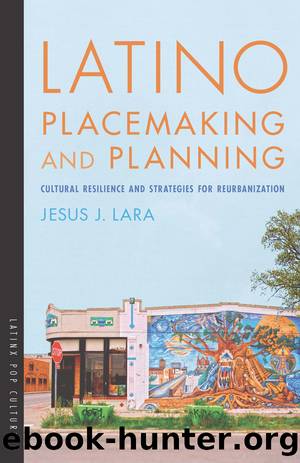Latino Placemaking and Planning by Jesus J. Lara

Author:Jesus J. Lara [Lara, Jesus J.]
Language: eng
Format: epub
ISBN: 9780816538171
Publisher: University of Arizona Press
The Latino population in Detroit has more than doubled in the past ten years. Latinos have been present in Detroit since the 1920s, but large numbers of Latino immigrants began moving to Mexicantown in the 1990s, and the numbers continue to rise. According to a study done by Erickson (2007), there are around four hundred thousand Latinos in Michigan, half of whom live in Detroit. The study neighborhood is located in southwest Detroit in the shadow of the Ambassador Bridge, a busy border crossing between the United States and Canada. It is an unusual neighborhood in that it is unlike most of Detroit, which is largely characterized by vacant lots, abandoned buildings, a declining urban population, chronically high unemployment, and high crime rates. Rather, in the West Vernor–Bagley Street Corridor and Mexicantown there are beautiful homes, manicured lawns, an increasing population, thriving small businesses, and a lively street life. The area has been going through different stages of the urban cycle, from construction to abandonment to reappropriation, since the early 1990s, but within the last twenty years the transformation process has become more persistent (Hispanic Population 2008, 9–10). Sadly, the area is sandwiched between I-75 and some of Michigan’s largest industrial plants. It and its surroundings constitute some of Michigan’s “most polluted zip codes,” according to an analysis by University of Michigan environmental scientists (Oosting 2010). In fact, the area comprising Mexicantown’s zip code of 48217 and that of its neighbors—home to both working-class neighborhoods and such industrial sites as the Marathon Oil Refinery and several asphalt plants—account for six of the ten most polluted zip codes in the state (Oosting 2010). The area has also been bisected by expansion plans of Detroit’s central business district and the addition of a freeway through the city (Alvarado 2003).
With all of its existing challenges and opportunities, the West Vernor–Bagley Street Corridor is an example of neighborhood revitalization through ethnic economic entrepreneurship. The local retail sector has been revitalized and provides a model on how to improve both the economy and quality of life of a public realm for its residents and visitors. A detailed analysis of business activities and census data with respect to the corridor shows changing spatial patterns and demonstrates how ethnic minority entrepreneurs are creating neighborhoods and giving new meaning to abandoned, unmaintained urban infrastructure. This case study also investigates the specific ways in which urban spaces are being transformed and modified to suit the needs and cultural preferences of their residents.
Detroit, and southeast Michigan in general, has experienced a dramatic increase in Latino population since the 1990s. As a result, demand for products and services tailored to this immigrant group has skyrocketed, with many businesses opening to accommodate the increasing purchasing power of Latinos. In the emerging Latino neighborhoods, visible changes in the retail landscape are often the only outward clues of this rapid ethnic transformation (Kaplan and Li 2006). One of the purposes of this case study is to examine how commercial establishments and small businesses can
Download
This site does not store any files on its server. We only index and link to content provided by other sites. Please contact the content providers to delete copyright contents if any and email us, we'll remove relevant links or contents immediately.
The Secret History by Donna Tartt(16611)
The Social Justice Warrior Handbook by Lisa De Pasquale(11486)
Thirteen Reasons Why by Jay Asher(7783)
This Is How You Lose Her by Junot Diaz(5755)
Weapons of Math Destruction by Cathy O'Neil(5032)
Zero to One by Peter Thiel(4818)
The Myth of the Strong Leader by Archie Brown(4787)
Promise Me, Dad by Joe Biden(4441)
Stone's Rules by Roger Stone(4413)
Beartown by Fredrik Backman(4406)
How Democracies Die by Steven Levitsky & Daniel Ziblatt(4393)
The Fire Next Time by James Baldwin(4338)
100 Deadly Skills by Clint Emerson(4072)
A Higher Loyalty: Truth, Lies, and Leadership by James Comey(4028)
Rise and Kill First by Ronen Bergman(4009)
The David Icke Guide to the Global Conspiracy (and how to end it) by David Icke(3876)
The Farm by Tom Rob Smith(3870)
Secrecy World by Jake Bernstein(3774)
The Doomsday Machine by Daniel Ellsberg(3726)
